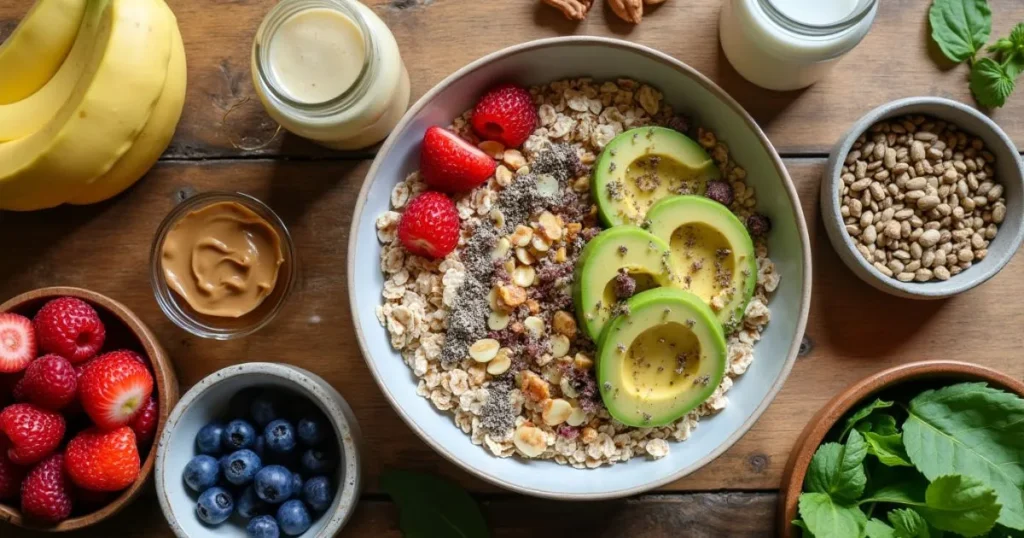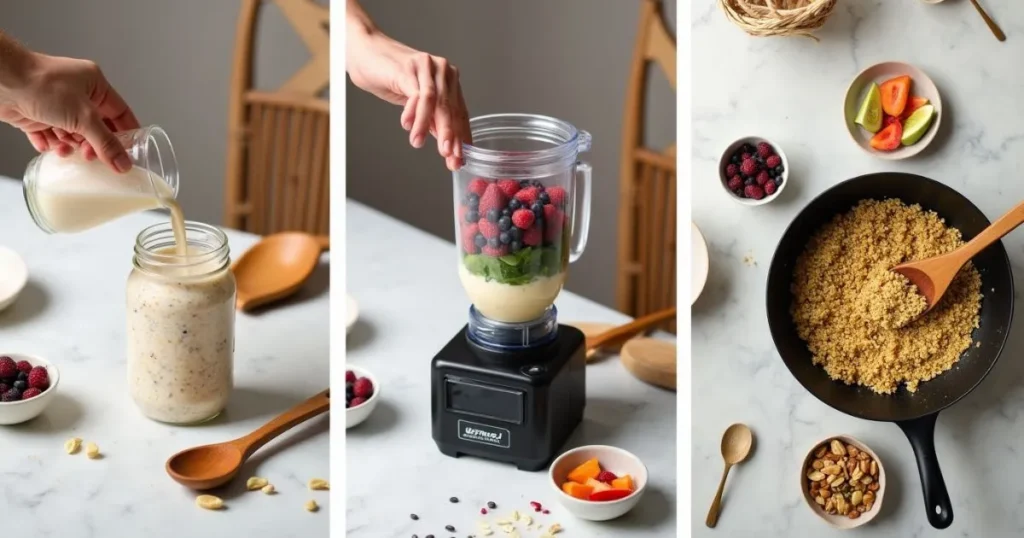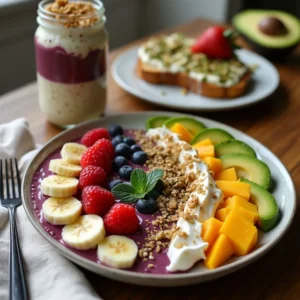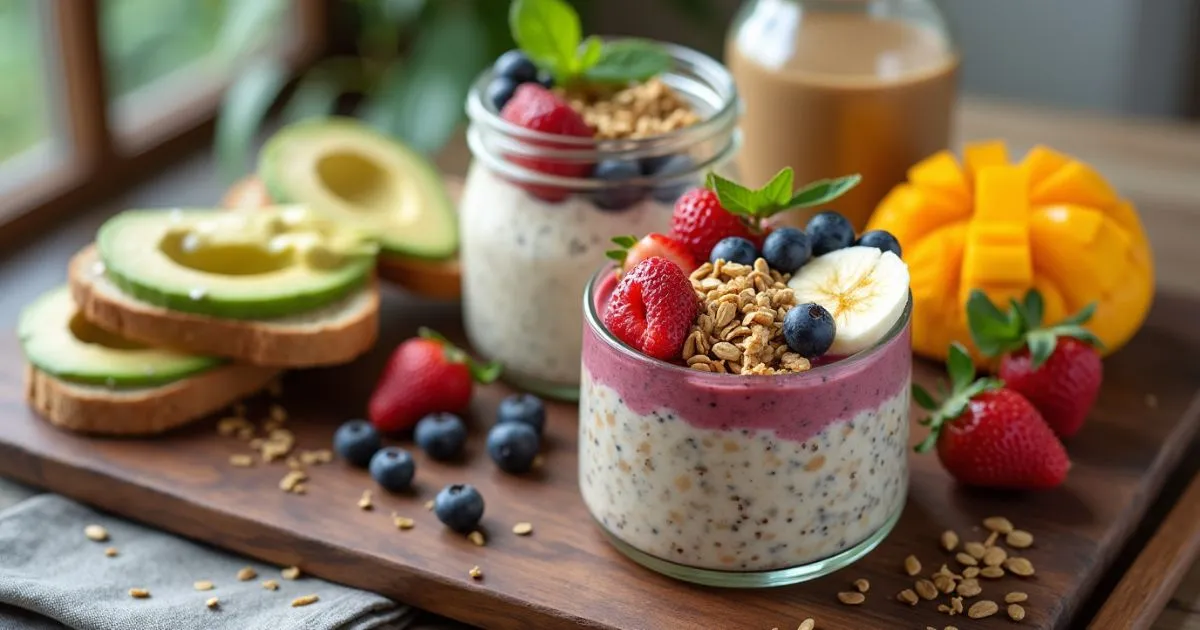Mornings can be hectic, but what if you could start your day with a breakfast that’s not only quick and easy but also nourishing and delicious? If you’re looking for plant-based whole food breakfast ideas that are packed with flavor and energy, you’re in the right place! Whether you’re a seasoned vegan or just exploring healthier options, these recipes are designed to fuel your day with wholesome, nutrient-rich ingredients. Imagine savoring vibrant, satisfying meals that leave you feeling energized and ready to tackle whatever comes your way. Ready to transform your mornings? Let’s dive in!
Table of Contents
Key Benefits of plant-based whole food breakfast ideas
Starting your day with plant-based whole food breakfast ideas isn’t just a trend—it’s a delicious way to nourish your body and mind. Here’s why these breakfasts are worth adding to your routine:
- Nutrient-Rich Powerhouse: Packed with vitamins, minerals, and antioxidants, plant-based whole foods like fruits, vegetables, nuts, and grains provide the energy you need to tackle your day.
- Heart-Healthy Choices: By skipping processed ingredients and focusing on whole foods, you’re supporting better heart health and lowering cholesterol naturally.
- Sustained Energy: Unlike sugary breakfasts that lead to mid-morning crashes, these meals are high in fiber and complex carbs, keeping you full and focused.
- Weight Management: Whole food plant-based meals are naturally lower in calories but high in volume, helping you feel satisfied without overeating.
- Versatility for Everyone: Whether you’re vegan, gluten-free, or just looking to eat cleaner, these recipes are customizable to fit your dietary needs.
Imagine waking up to a breakfast that not only tastes amazing but also leaves you feeling vibrant and ready to take on the world. Sounds good, right? Let’s make it happen!
Ingredients for plant-based whole food breakfast ideas

Here’s what you’ll need to bring these recipes to life:
Pantry Staples:
- Rolled oats or quinoa: A hearty base for bowls or porridge.
- Chia seeds or flaxseeds: Perfect for adding a boost of omega-3s and fiber.
- Nut butter (almond, peanut, or cashew): Adds creaminess and healthy fats.
- Plant-based milk (almond, oat, or soy): A versatile liquid for smoothies or cereals.
- Maple syrup or dates: Natural sweeteners to enhance flavor without refined sugar.
Fresh Produce:
- Bananas, berries, or apples: Fresh fruits for natural sweetness and vitamins.
- Leafy greens (spinach or kale): Sneak in extra nutrients for a green boost.
- Avocado: Creamy and rich, perfect for toast or smoothies.
Toppings and Extras:
- Nuts and seeds (walnuts, almonds, pumpkin seeds): For crunch and added protein.
- Coconut yogurt or dairy-free yogurt: A tangy, creamy addition to bowls.
- Cinnamon, vanilla extract, or cacao powder: Flavor enhancers to elevate your dish.
Why These Ingredients Work:
These whole food ingredients are not only easy to find but also versatile, allowing you to mix and match based on what’s in your kitchen. Plus, they’re packed with nutrients to keep you energized all morning long.
Pro Tip: If you’re short on time, prep your ingredients the night before. Wash and chop fruits, soak oats, or blend smoothie packs to save time in the morning.
How to Make Plant-Based Whole Food Breakfast Ideas

Ready to whip up a plant-based whole food breakfast that’s as easy as it is delicious? Follow these simple steps to create a meal that’s both nourishing and satisfying. Whether you’re a kitchen novice or a seasoned pro, these recipes are designed to fit seamlessly into your morning routine.
Step 1: Choose Your Base
Start with a hearty foundation like:
- Overnight oats: Combine rolled oats, plant-based milk, and chia seeds in a jar. Let it sit overnight for a no-cook option.
- Smoothie bowl: Blend frozen bananas, berries, and plant-based milk until thick and creamy.
- Quinoa porridge: Cook quinoa with plant-based milk and a pinch of cinnamon for a protein-packed alternative to oatmeal.
Step 2: Add Fresh Fruits and Veggies
Incorporate a variety of colors and textures:
- Top your oats or quinoa with sliced bananas, berries, or diced apples.
- Blend leafy greens like spinach or kale into your smoothie for an extra nutrient boost.
- Add avocado slices to whole-grain toast for a creamy, satisfying option.
Step 3: Boost with Toppings and Extras
Elevate your breakfast with these flavorful additions:
- Sprinkle nuts and seeds like almonds, walnuts, or pumpkin seeds for crunch and protein.
- Drizzle nut butter or a touch of maple syrup for richness and sweetness.
- Add a dollop of coconut yogurt or a dusting of cacao powder for a decadent finish.
Step 4: Customize to Your Taste
Don’t be afraid to get creative! Swap ingredients based on what you have or your dietary preferences. For example:
- Use gluten-free oats if needed.
- Substitute dates for maple syrup as a natural sweetener.
- Try different plant-based milks like oat, almond, or soy to change up the flavor.
Step 5: Serve and Enjoy
Once your breakfast is ready, take a moment to savor it. Pair it with a cup of herbal tea or freshly brewed coffee for the perfect start to your day.
Pro Tips and Variations for plant-based whole food breakfast ideas
Even the simplest plant-based whole food breakfast can be elevated with a few expert tips and creative twists. Here’s how to make your morning meals even more delightful and tailored to your preferences:
Pro Tips for Success:
- Prep Ahead: Save time by prepping ingredients the night before. Soak oats, chop fruits, or blend smoothie packs and store them in the fridge.
- Batch Cooking: Make a big batch of quinoa or oatmeal at the start of the week. Reheat portions each morning for a quick, wholesome breakfast.
- Layer Textures: Combine creamy, crunchy, and chewy elements (like yogurt, nuts, and fresh fruit) to keep every bite interesting.
- Balance Flavors: Mix sweet and savory ingredients—think almond butter with banana or avocado with a sprinkle of chili flakes.
Creative Variations:
- Tropical Smoothie Bowl:
- Blend frozen mango, pineapple, and coconut milk for a tropical twist.
- Top with shredded coconut, chia seeds, and a handful of granola.
- Savory Breakfast Bowl:
- Use quinoa as a base and top with sautéed spinach, roasted sweet potatoes, and a drizzle of tahini.
- Add a sprinkle of hemp seeds for extra protein.
- Chocolate Peanut Butter Overnight Oats:
- Mix oats with cacao powder, peanut butter, and plant-based milk.
- Top with banana slices and a handful of dark chocolate chips for a treat-like breakfast.
- Green Power Smoothie:
- Blend spinach, frozen banana, avocado, and almond milk for a creamy, nutrient-packed drink.
- Add a scoop of plant-based protein powder for an extra boost.
Dietary Adaptations:
- Gluten-Free: Use certified gluten-free oats or swap in quinoa or buckwheat.
- Nut-Free: Replace nut butter with sunflower seed butter and skip nuts as toppings.
- Lower Sugar: Sweeten naturally with mashed bananas or a small amount of dates instead of maple syrup.
Storage Tips:
- Store prepped ingredients in airtight containers for up to 3 days.
- Smoothie bowls and overnight oats are best enjoyed fresh but can be refrigerated for up to 24 hours.
Serving Suggestions for plant-based whole food breakfast ideas
A plant-based whole food breakfast isn’t just about taste—it’s about creating a morning experience that feels special and satisfying. Here are some ideas to make your breakfast visually appealing, delicious, and perfectly suited to your mood or occasion:
Presentation Tips:
- Colorful Bowls: Use vibrant fruits like berries, mango, or kiwi to add a pop of color to your smoothie bowls or oatmeal.
- Layering: Create visually stunning parfaits by layering yogurt, granola, and fresh fruit in a clear glass or jar.
- Garnishes: Sprinkle toppings like shredded coconut, cacao nibs, or edible flowers for a gourmet touch.
Pairing Ideas:
- With Beverages: Pair your breakfast with a cup of herbal tea, freshly brewed coffee, or a glass of cold-pressed juice for a complete morning ritual.
- With Sides: Add a slice of whole-grain toast with avocado or a small handful of nuts for extra staying power.
Occasion-Based Serving Ideas:
- Quick Weekday Breakfast:
- Serve smoothie bowls or overnight oats in portable jars for an on-the-go option.
- Pair with a piece of fresh fruit for a balanced meal.
- Weekend Brunch:
- Create a breakfast spread with a variety of toppings (nuts, seeds, fruits, and spreads) for a DIY oatmeal or smoothie bowl bar.
- Add a side of roasted sweet potatoes or plant-based pancakes for a hearty treat.
- Special Occasions:
- Elevate your breakfast with elegant touches like chia seed puddings in fancy glasses or quinoa bowls garnished with pomegranate seeds.
- Serve with a mimosa made with sparkling water and fresh orange juice for a festive vibe.
Kid-Friendly Options:
- Turn smoothie bowls into fun creations by arranging fruit slices into smiley faces or animal shapes.
- Let kids customize their own oatmeal or yogurt bowls with their favorite toppings.
On-the-Go Tips:
- Pack pre-portioned smoothie ingredients in freezer bags—just blend with plant-based milk in the morning.
- Use portable containers for overnight oats or chia puddings that can be eaten straight from the fridge.
Conclusion
Starting your day with plant-based whole food ideas breakfast is more than just a healthy choice—it’s a way to nourish your body, boost your energy, and set a positive tone for the day ahead. These recipes are designed to be simple, versatile, and packed with flavor, so you can enjoy every bite without sacrificing time or taste.
Whether you’re blending up a vibrant smoothie bowl, savoring a bowl of creamy overnight oats, or experimenting with savory quinoa bowls, these meals prove that eating well doesn’t have to be complicated. Plus, with endless customization options, you can tailor each recipe to suit your preferences and dietary needs.
So, why not give it a try? Whip up one of these breakfasts tomorrow morning and see how good it feels to fuel your body with wholesome, plant-based ingredients. Remember, small changes can lead to big results, and your journey to a healthier, more vibrant lifestyle starts right here, one delicious bite at a time.

plant-based whole food breakfast ideas
Ingredients
- Rolled oats quinoa, or bananas
- Plant-based milk almond, oat, or soy
- Chia seeds or flaxseeds
- Nut butter
- Fresh fruits banana, berries, or apples
- Leafy greens optional
- Nuts seeds, or coconut yogurt
- Maple syrup or dates
Instructions
- Base: Prepare oats, smoothie, or quinoa porridge.
- Toppings: Add fruits, nuts, and yogurt.
- Customize: Sweeten with maple syrup or dates.
- Serve: Enjoy fresh with tea or coffee.
Video
Notes
- Calories: 320 kcal
- Fat: 12g (Healthy fats from nuts, seeds, and avocado)
- Protein: 10g (From oats, quinoa, nuts, and seeds)
- Carbohydrates: 45g (Complex carbs from whole grains and fruits)
- Fiber: 8g (From oats, chia seeds, and fresh produce)
- Sugar: 15g (Natural sugars from fruits and minimal added sweeteners)
- Sodium: 50mg (Naturally low in sodium)
FAQs
Got questions about plant-based whole food breakfast ideas? Don’t worry—I’ve got you covered! Here are answers to some common queries to help you master these recipes and make your mornings easier and more delicious.
1. Can I make these recipes ahead of time?
Absolutely! Many of these breakfasts are perfect for meal prep:
–Overnight oats can be made 2-3 days in advance and stored in the fridge.
–Smoothie packs can be prepped and frozen—just blend with plant-based milk when ready.
–Cooked quinoa or oatmeal can be refrigerated for up to 4 days and reheated as needed.
2. Are these recipes gluten-free?
Most of them can be! Simply use certified gluten-free oats or swap in quinoa or buckwheat as a base. Always check labels on packaged ingredients like plant-based milk or granola to ensure they’re gluten-free.
3. How can I add more protein to my plant-based breakfast?
Try these easy protein boosts:
-Add a scoop of plant-based protein powder to smoothies or oatmeal.
-Top your meal with nuts, seeds, or nut butter.
-Incorporate tofu or tempeh into savory breakfast bowls.
4. What if I don’t have fresh fruit on hand?
No problem! Frozen fruits work just as well in smoothies or oatmeal. You can also use dried fruits like raisins, apricots, or dates for sweetness and texture.
5. Can I make these recipes nut-free?
Yes! Swap nut butter for sunflower seed butter or tahini, and skip nuts as toppings. Use seeds like pumpkin or sunflower seeds for crunch instead.
6. How do I store leftovers?
-Store smoothie bowls and overnight oats in airtight containers in the fridge for up to 24 hours.
Keep cooked grains like quinoa or oatmeal in the fridge for 3-4 days. Reheat with a splash of plant-based milk to restore creaminess.
7. Are these recipes kid-friendly?
Definitely! Kids love customizable meals. Let them build their own oatmeal or smoothie bowls with fun toppings like fresh fruit, granola, or a drizzle of maple syrup.
Recipe Recap: Delicious Plant-Based Whole Food Breakfast Ideas
Recipe Details
- Prep Time: 10 minutes
- Cook Time: 5 minutes (if cooking quinoa or oatmeal)
- Total Time: 15 minutes
- Servings: 2
- Calories per Serving: ~300-350 kcal
Nutrition Information (Per Serving)
- Calories: 320 kcal
- Fat: 12g (Healthy fats from nuts, seeds, and avocado)
- Protein: 10g (From oats, quinoa, nuts, and seeds)
- Carbohydrates: 45g (Complex carbs from whole grains and fruits)
- Fiber: 8g (From oats, chia seeds, and fresh produce)
- Sugar: 15g (Natural sugars from fruits and minimal added sweeteners)
- Sodium: 50mg (Naturally low in sodium)
Categorization
- Course: Breakfast
- Cuisine: Global (Versatile and adaptable to various cuisines)
- Diet: Vegan, Vegetarian, Gluten-Free (with certified GF oats), Nut-Free (with substitutions)
- Method: No-Cook (Overnight Oats, Smoothie Bowls) or Stovetop (Quinoa Porridge)
- Keyword: Plant-Based Whole Food Breakfast Ideas
- Skill Level: Beginner-Friendly
